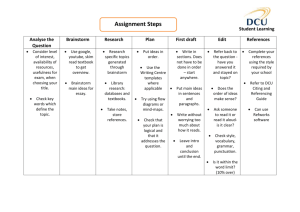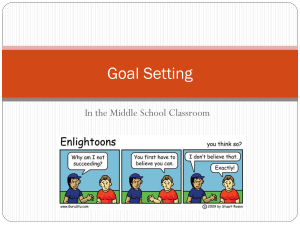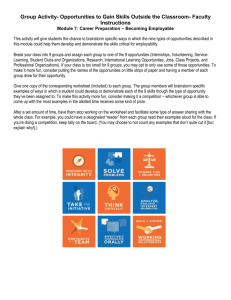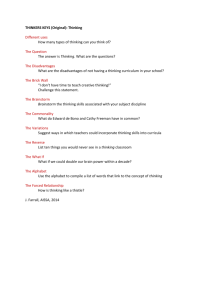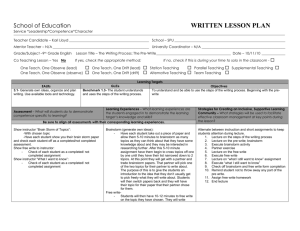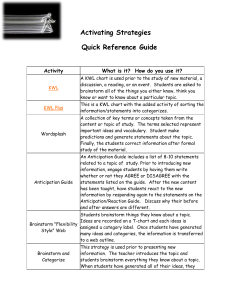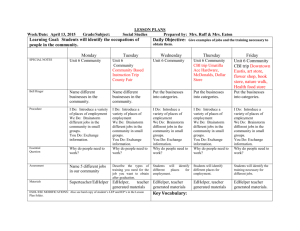Problem Solving Assignment
advertisement
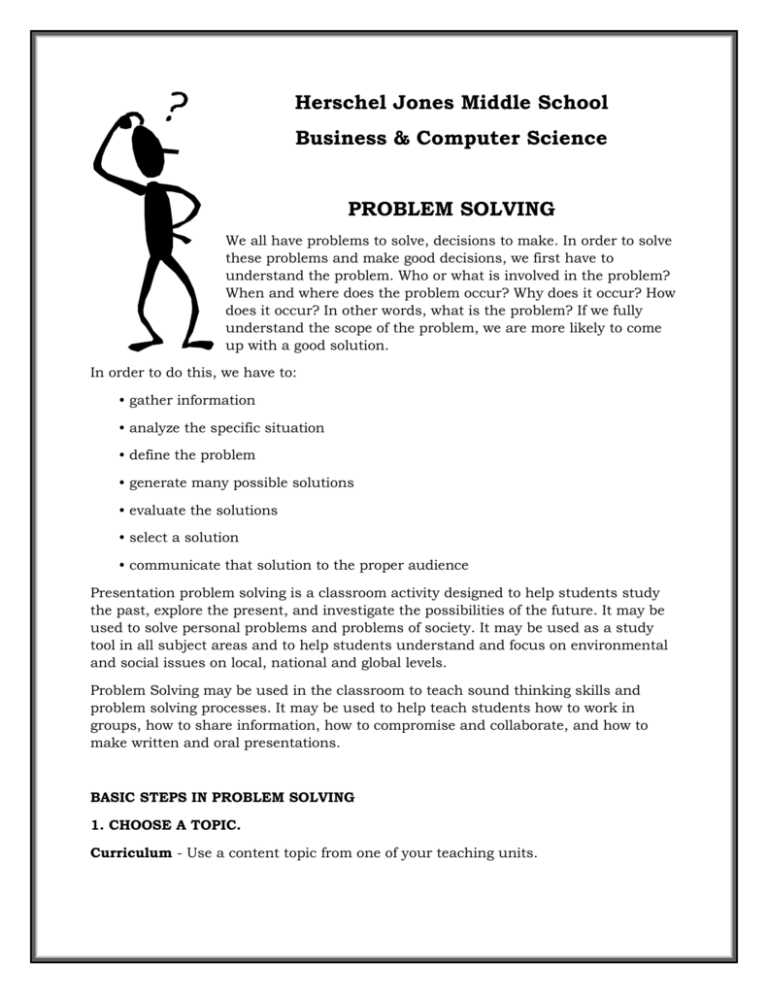
Herschel Jones Middle School Business & Computer Science PROBLEM SOLVING We all have problems to solve, decisions to make. In order to solve these problems and make good decisions, we first have to understand the problem. Who or what is involved in the problem? When and where does the problem occur? Why does it occur? How does it occur? In other words, what is the problem? If we fully understand the scope of the problem, we are more likely to come up with a good solution. In order to do this, we have to: • gather information • analyze the specific situation • define the problem • generate many possible solutions • evaluate the solutions • select a solution • communicate that solution to the proper audience Presentation problem solving is a classroom activity designed to help students study the past, explore the present, and investigate the possibilities of the future. It may be used to solve personal problems and problems of society. It may be used as a study tool in all subject areas and to help students understand and focus on environmental and social issues on local, national and global levels. Problem Solving may be used in the classroom to teach sound thinking skills and problem solving processes. It may be used to help teach students how to work in groups, how to share information, how to compromise and collaborate, and how to make written and oral presentations. BASIC STEPS IN PROBLEM SOLVING 1. CHOOSE A TOPIC. Curriculum - Use a content topic from one of your teaching units. School - Identify a problem in your school. Have the students brainstorm what they perceive as problems - noisy cafeteria, fighting on the bus, graffiti in the restrooms, too many students in the halls, etc. 2. GATHER INFORMATION. Curriculum - The goal is to learn as much as possible about the topic. Have students share their information with each other. School - Ask the students to research some or all of the problems they have identified. Have them gather data about the problems they have identified. On what bus does the fighting occur? When does the fighting occur - before or after school? At what time of day is it the nosiest in the cafeteria? Who supervises the cafeteria? 3. NARROW THE SCOPE. Have the student’s select one problem. Have them define the problem and create solutions in several different directions. Curriculum - Have a group working together and generating lots of different ideas. School - Fighting on the bus is the problem the students want to work on. 4. BRAINSTORM THE SUBPROBLEMS. Have the students analyze the situation and list as many of the sub-problems as possible related to that problem. 5. IDENTIFY THE MAIN PROBLEM (the problem to be solved). This may be one of the most difficult steps. What exactly is the problem in this situation? Is there just one problem or is there a combination of several issues? At this point, the students must define the problem. The “problem” might be defined as the cause. 6. BRAINSTORM SOLUTIONS. Have the students brainstorm as many solutions to the problem (not the situation) that they have defined. 7. EVALUATE THE SOLUTIONS. In order to find the best solutions, students must evaluate their solutions and select the one solution or combination of solutions that will best solve the problem. Ways to evaluate the solution might include: the cost of the solution, the people involved in executing the solution, the ways of communicating the solution, the results if this solution is used. What is the most promising solution? What will give the most benefit to the most people? Is the solution feasible? 8. CHOOSE AND DRAW CONCLUSIONS. SUMMARIZE AND DESCRIBE THE “BEST” SOLUTION. WHO? WHAT? WHEN? WHERE? HOW? Sample Problems… The Game Your brother is the star of the local softball team. During the season, the whole family goes to his ball games three times a week. At the end of the season, the team plays in a tournament. They play every night until they lose. They have played two nights this week and will play again tonight. You have a big project due at school. You really don’t want to tell your parents because they might make you stay home from the game. Brainstorm some of the problems related to this situation. Select a main problem and brainstorm possible solutions. Prepare a presentation to illustrate your problem and solution. The Neighborhood Bully There is a boy who lives down the street who is bigger than you. The rest of the kids in the neighborhood look up to him. You really don’t like him, but you are afraid of him and you are afraid of losing your friends if you are not friends with him. When no one else is around, he bullies you. You are afraid to tell, because you don’t think people will believe you and you don’t want to be a tattletale. There are several problems in this situation. What can you do about it? 25 School Lunches You have a new cafeteria manager at your school. She is very concerned about the health of the students. She believes that lunches should be good for you and is very careful to include all of the right foods in the lunch program. Some days, the students at your school waste a lot of food because they don’t like what has been prepared. What is the problem here? What are some of the possible solutions? What is the best solution? The Pet Pig Your older brother has a dog. While you love the dog, he belongs to your brother. You want a pet of your own. You really want a potbellied pig. Your mother has said, “No!” Your father seems to be considering it. Brainstorm all of the things you would have to consider if you got a pig. Prepare a check list. Make a presentation to convince your mother and father to let you have a pig.

